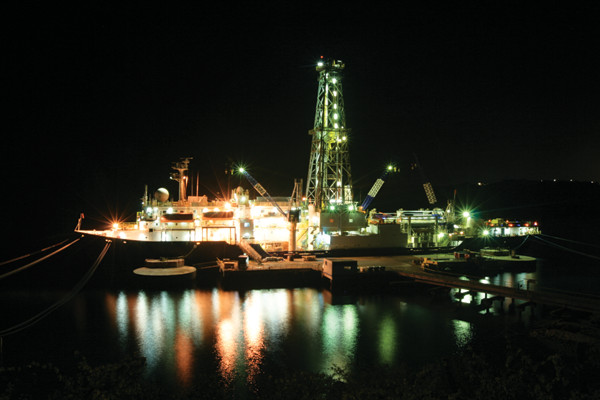
by John Van Hoesen Friday, July 20, 2012

The JOIDES Resolution. John Van Hoesen
In the late 1950s, a growing interest in better understanding the structure and composition of Earth resulted in the creation of the controversial Project Mohole. Although the name may sound better suited for an Isaac Asimov novel, it was indeed a real, albeit short-lived, attempt to drill through the boundary between the crust and mantle, called the Mohorovičić (Moho) discontinuity — an engineering feat yet to be achieved. The project led to the modern-day Integrated Ocean Drilling Program (IODP) — and eventually the School of Rock.
IODP has a number of predecessors to which it owes its existence: First there was the Deep Sea Drilling Project, established in the late 1960s and administered by the Joint Oceanographic Institutions for Deep Earth Sampling (JOIDES); then the Ocean Drilling Program was established in 1985. IODP followed in 2003.
Most geologists are likely familiar with the workhorse of the Deep Sea Drilling Project, the Glomar Challenger — a deep-ocean drilling research vessel named for its parent company Global Marine and after an Australian warship commissioned for oceanographic research. Its primary mission was to single-mindedly pursue scientific exploration — essentially science for the sake of science — to better understand Earth dynamics and the deep ocean.
The success of these programs can be measured by how much they have contributed to our current understanding of Earth. Early evidence from drill sites throughout the Atlantic Ocean provided support for the concept of seafloor spreading and thus plate tectonics, offered insight into the age of oceanic crust relative to continental crust, gave us a better understanding of the mineralogy and structure of oceanic crust, and suggested the existence of large-scale salt domes — sparking additional exploration focused on oil traps and recovery mechanisms.
With the establishment of the Ocean Drilling Program came a new deep-sea drilling vessel, the JOIDES Resolution, named after the British sloop HMS Resolution commanded by Captain James Cook in the 1700s that explored the Arctic, Southern and Pacific oceans. The ship, now governed by IODP, underwent a renovation and modernization of the science labs and living quarters in 2009. Over the last 27 years, it has drilled about 2,000 holes at 765 sites. Although the mission of IODP is still primarily focused on scientific exploration, the program illustrated its commitment to education in 2005 by creating the School of Rock.
© 2008-2021. All rights reserved. Any copying, redistribution or retransmission of any of the contents of this service without the expressed written permission of the American Geosciences Institute is expressly prohibited. Click here for all copyright requests.